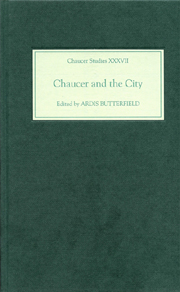Book contents
11 - After the Fire: Chaucer and Urban Poetics, 1666–1743
from AFTERLIVES
Published online by Cambridge University Press: 05 February 2013
Summary
The London destroyed by the Great Fire was Chaucer's London. As dawn broke over the capital on 2 September 1666, ‘London within the wall remained a medieval city’, and it was predominantly London within the wall that had been reduced to ashes by sundown on 7 September. More particularly, the fire originated in London's most Chaucerian neighbourhood. During the period he was resident in the city as Controller of the Wool Custom, the poet would most days have walked the half-mile or so from Aldgate to the Wool Quay, near Billingsgate, between the Tower and London Bridge; and that half-mile, plus the further ten minutes' walk along Thames Street required to reach his father's house in the Vintry Ward, took Chaucer through the epicentre of the conflagration. Once the flames had passed on eastwards and northwards, Samuel Pepys took much the same route, surveying the damage. The diarist was a great admirer of Chaucer, put on to the Canterbury Tales and Troilus and Criseyde during his early days in naval adminstration by the veteran mariner Sir John Mennes, and responsible in later life for persuading Dryden to ‘translate’ the portrait of the Parson from the General Prologue. With his taste for farce and gift for the colloquial, he is often described as a Chaucerian writer. Yet there is no sign in his celebrated account of ‘walking through the town among the hot coals’ with his friends Mr Young and Mr Whistler, ‘our feet ready to burn’, that Pepys realised they were treading on the ashes of Chaucer's London.
- Type
- Chapter
- Information
- Chaucer and the City , pp. 177 - 192Publisher: Boydell & BrewerPrint publication year: 2006

